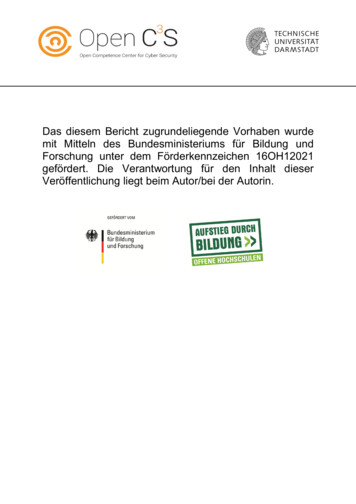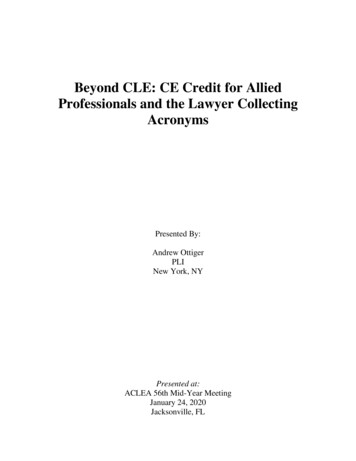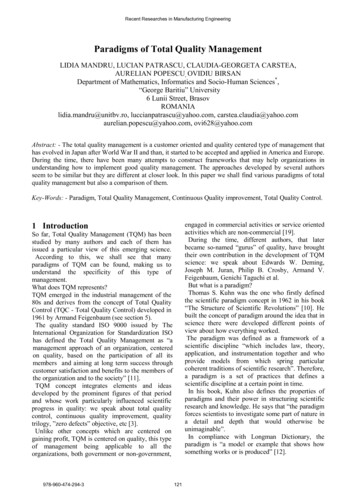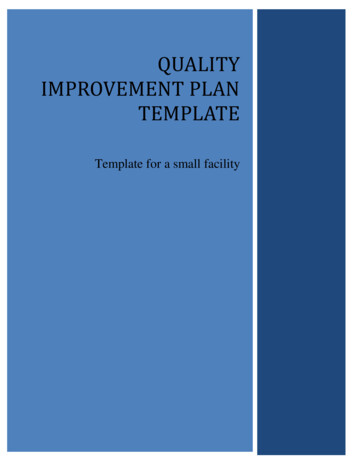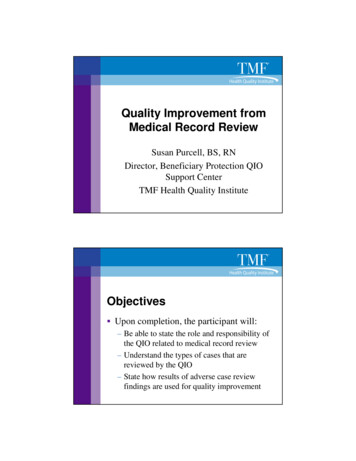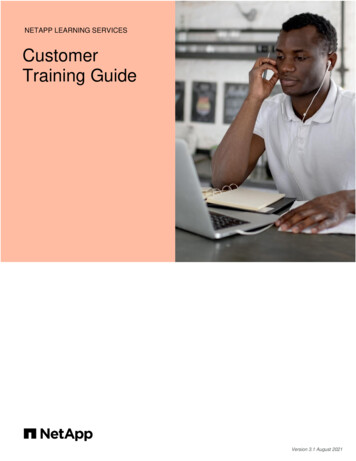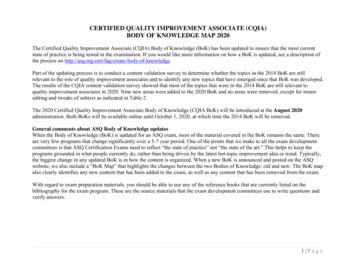
Transcription
CERTIFIED QUALITY IMPROVEMENT ASSOCIATE (CQIA)BODY OF KNOWLEDGE MAP 2020The Certified Quality Improvement Associate (CQIA) Body of Knowledge (BoK) has been updated to ensure that the most currentstate of practice is being tested in the examination. If you would like more information on how a BoK is updated, see a description ofthe process on art of the updating process is to conduct a content validation survey to determine whether the topics in the 2014 BoK are stillrelevant to the role of quality improvement associates and to identify any new topics that have emerged since that BoK was developed.The results of the CQIA content validation survey showed that most of the topics that were in the 2014 BoK are still relevant toquality improvement associates in 2020. Nine new areas were added to the 2020 BoK and no areas were removed, except for minorediting and tweaks of subtext as indicated in Table 2.The 2020 Certified Quality Improvement Associate Body of Knowledge (CQIA BoK) will be introduced at the August 2020administration. Both BoKs will be available online until October 1, 2020, at which time the 2014 BoK will be removed.General comments about ASQ Body of Knowledge updatesWhen the Body of Knowledge (BoK) is updated for an ASQ exam, most of the material covered in the BoK remains the same. Thereare very few programs that change significantly over a 5-7 year period. One of the points that we make to all the exam developmentcommittees is that ASQ Certification Exams need to reflect “the state of practice” not “the state of the art.” This helps to keep theprograms grounded in what people currently do, rather than being driven by the latest hot-topic improvement idea or trend. Typically,the biggest change in any updated BoK is in how the content is organized. When a new BoK is announced and posted on the ASQwebsite, we also include a “BoK Map” that highlights the changes between the two Bodies of Knowledge: old and new. The BoK mapalso clearly identifies any new content that has been added to the exam, as well as any content that has been removed from the exam.With regard to exam preparation materials, you should be able to use any of the reference books that are currently listed on thebibliography for the exam program. These are the source materials that the exam development committees use to write questions andverify answers.1 Page
Specific comments about the 2020 CQIA Body of Knowledge updatesThe CQIA Body of Knowledge mostly stayed the same with more topics added to the 2020 update. Three new topics were added toSection I: Quality systems (I.A.3), Organizational culture (I.A.4), and Standardization (I.A.8). There were no major changes to contentin Section II. Two new topics were added to Section III: Root cause analysis (III.D) and Risk management (III.E). Two new topicswere added to Section IV: Supplier selection (IV.A) and Supplier relationship (IV.B). Section IV was separated to include Suppliertopics only, removing Customer. Section V was created to include Customer only. Two new topics were added to Section V:Complaint process (V.B.2) and Customer needs (V.B.3). In addition to a total of nine new topics and minor removal/edits of content,there were two topics that received an increase in level of cognition: III.B and IV.C.Table 1 below portrays the change in items allocated to each section of the Body of Knowledge. The name for Section III has beenupdated and Section IV has been split into two sections in the 2020 BoK, Section IV. Supplier Relationship, and Section V. CustomerRelationship. Table 2, on page 3, presents the 2020 CQIA BoK and maps the topics to the 2014 BoK. Table 3, starting on Page 8,presents the 2014 CQIA BoK and maps the topics to the 2020 BoK. Details on changes between the two can be found below.Table 1. BoK Section Item AllocationBoK SectionI. Quality BasicsII. Team BasicsIII. Continuous Improvement TechniquesIV. Customer-Supplier Relations2014 BoKItems30203020BoK SectionI. Quality BasicsII. Team BasicsIII. ImprovementIV. Supplier RelationshipV. Customer Relationship2020 BoKChangeItems30 /- 016-440 107-672 Page
Table 2. 2020 CQIA BoK mapped to the 2014 CQIA BoK2020 BoK Details2014 BoK CodeI.I.AI.A.1I.A.2NEWNEWI.A.3I.A.4I.A.5NEWQuality Basics [30 Questions]NotesSection renamed to “Quality Basics”A. Terms, concepts, and principles1. Quality definitionsDescribe and distinguish between the common definitions of quality. (Apply)2. Quality planDefine a quality plan, describe its purpose and objectives to achieve the quality mission orpolicy. Identify the various functional areas and people having responsibility forcontributing to its development. (Understand)3. Quality systemsUnderstand the difference and relationship between quality assurance, quality control, andcontinuous quality improvement. (Understand)4. Organizational cultureUnderstand how culture influences the success of process improvement efforts such aslean, six sigma, ISO 9001, Baldrige, and change management. (Understand)5. Employee involvement and empowermentDefine and distinguish between employee involvement and employee empowerment.Describe the benefits of both concepts. (Understand)6. Systems and processesDefine and distinguish between a system and a process and describe the interrelationshipsbetween them. Describe the components of a system – supplier, input, process, output,customer (SIPOC) – and how these components impact the system as a whole. (Analyze)7. VariationDefine and distinguish between common and special cause variation in relation to qualitymeasures. (Understand)8. StandardizationDescribe how quality systems provide consistency and standardization (e.g. ISO 9001).(Remember)Added “definitions” to topic nameRevised subtext for clarificationUpdated subtext for clarificationB. Benefits of qualityI.BDescribe how using quality tools, techniques, and concepts can improve processes anddeliverables (including products and services), and how each benefit all parts of anorganization. Describe what quality means to various stakeholders (e.g., employees,organizations, customers, suppliers, community, and interested parties) and how each canbenefit from quality. (Understand)Added “tools”, “concepts”, and “deliverablesand, also added “interested parties”3 Page
2020 BoK Details2014 BoK CodeNotesUpdated topic nameC. Foundations of qualityUnderstand the key concepts and teachings of the foundational quality thought leadersincluding 1) Walter Shewhart, 2) W. Edwards Deming, 3) Joseph Juran, 4) Kaoru Ishikawa,5) Philip Crosby, and 6) Armand Feigenbaum. (Understand)I.CUpdated subtext to include the qualitythought leaders and their key concepts andteachings and changed 1-5 from the theory tothe quality leaderAdded 6) Armand FeigenbaumII.II.AII.A.1II.A.2II.A.3Team Basics [16 Questions]A. Team organization1. Team purposeDescribe why teams are an effective way to identify and solve problems, and describewhen, where, why, and how teams can be used effectively. (Apply)2. Types of teamsDefine and distinguish between various types of teams: process teams, continuousimprovement teams, workgroups, self-managed teams, ad hoc project teams, crossfunctional teams, and virtual teams. (Apply)3. Value of teamsExplain how a team’s efforts can support an organization’s key strategies and effectpositive change throughout the organization. (Understand)B. Roles and responsibilitiesII.BII.CII.C.1II.C.2II.C.3Number of questions decreased from 20 to 16Describe the roles and responsibilities of various team stakeholders, such as 1) sponsor, 2)champion, 3) facilitator, 4) leader, 5) member, 6) scribe, and 7) timekeeper. (Understand)Updated subtextRemoved temporary teams and added virtualteamsAdded 6) scribe and 7 ) timekeeperC. Team formation and group dynamics1. Initiating teamsApply the elements of launching and sustaining a successful team, including establishing aclear purpose and goals, developing ground rules and schedules, gaining support frommanagement, and obtaining commitment from team members. (Apply)2. Selecting team membersDescribe how to select team members based on knowledge, skill sets, and team logistics,such as an adequate number of members in relation to the size or scope of the project,appropriate representation from affected departments or areas, and diversity. (Apply)3. Team stagesDescribe the classic stages of team development: forming, storming, norming, performing,and adjourning. (Understand)Added “adjourning”4 Page
2020 BoK Details2014 BoK Code4. Team conflictIdentify the value of team conflict and recognize how to resolve it. Define and describegroupthink and how to overcome it. Determine how good logistics, an agenda, andeffective training facilitate team success. (Analyze)II.C.45. Team decision-makingDescribe and use different decision-making models, such as voting (majority rule, multivoting) and consensus. Use follow-up techniques to clarify the issue to be decided, toconfirm agreement on the decision, and to achieve closure. (Apply)II.C.5III.III.BImprovement [40 Questions]NotesReplaced “poor” with “good”Removed “lack of” and “become barriers”Added “facilitate”Updated subtext for clarificationUpdated section nameNumber of questions increased from 30 to 40A. Process improvementUpdated subtopic nameIII.B.11. Six Sigma concepts and toolsCompare six sigma concepts, tools, and techniques. Understand the DMAIC phases:define, measure, analyze, improve, and control. (Understand)Removed “the different roles andresponsibilities of green belts, black belts,typical project types”Changed “design” to “define”III.B.2III.B.3III.B.42. Lean concepts and toolsCompare lean concepts, tools, and techniques. Understand lean tools used to reduce waste,including set-up and cycle-time reduction, pull systems (kanban), continuousimprovement (kaizen), just-in-time (JIT), 5S, value stream mapping, and error-proofing(poka-yoke). (Understand)3. BenchmarkingDefine benchmarking and describe how it can be used to develop and support bestpractices. (Understand)4. Incremental and breakthrough improvementDescribe and distinguish between these two types of improvements, the steps required foreach, and the type of situation in which either type would be expected. (Understand)B. Improvement techniquesIII.ASelect and utilize improvement opportunity techniques and/or methodologies including 1)brainstorming, 2) plan-do-check-act (PDCA) cycle, 3) affinity diagrams, 4) cost of poorquality (COPQ) and, 5) internal audits. (Apply)Updated subtopic nameAdded “error-proofing (poka-yoke)”Updated topic nameUpdated cost of quality to cost of poor qualityIncreased cognitive level to Apply5 Page
2020 BoK Details2014 BoK CodeNotesUpdated topic nameC. Improvement toolsSelect, interpret, and apply the basic improvement tools including 1) flowcharts, 2)histograms, 3) Pareto charts, 4) scatter diagrams, 5) check sheets, 6) control charts, and 7)decision trees. (Apply)III.CAdded “decision trees” and removed“Describe and interpret basic control chartconcepts, including centerlines, control limitsand out-of-control conditions”Moved “Cause and effect diagram” to III.DD. Root cause analysisUtilize root cause tools such as the 5 whys and fishbone diagram to implement correction andcorrective action. (Apply)NEWE. Risk managementUnderstand the tools and techniques used to identify and communicate risks, including failuremodes and effects analysis (FMEA) and strength-weakness-opportunity-threat (SWOT).Understand prioritization of activities and projects based on risk. (Understand)NEWIV.Supplier Relationship [7 Questions]Updated section nameNumber of questions decreased from 20 to 7A. Supplier selectionNEWIdentify the supplier selection criteria and approval process. (Remember)B. Supplier relationshipUnderstand supplier relationships, associated challenges, and effects of a diverse supply base.(Understand)NEWC. Supplier performanceIdentify supplier performance measures, including quality performance, on-time delivery, andlevel of service. (Apply)IV.CNEWV.Updated topic nameIncreased cognitive level to ApplyRemoved “Describe commonly used metrics,including product defect rates’ functionalperformance, and delivery timeliness; serviceor process responsiveness and availability andcompetence of technical support”Customer Relationship [7 Questions]6 Page
2014 BoK Code2020 BoK DetailsA. Customer identificationIV.ANEWIV.BNEWNEWDistinguish between internal and external customers. Describe their influence on products,services, and processes. (Understand)NotesUpdated topic nameRemoved “suppliers” and “identify strategiesfor working with them to makeimprovements”B. Voice of the customer (VOC)1. Data gathering and useDescribe various methods for collecting customer satisfaction feedback, including formalsurveys, informal feedback, warranty claims, and focus groups. Understand theimportance of using customer satisfaction feedback to drive continuous improvement.(Understand)2. Complaint processDefine and identify a customer complaint and complaint handling process includingdocumentation, action taken, and providing resolve to the customer. (Apply)3. Customer needsUnderstand the key elements of quality function deployment (QFD) and how it identifiesand prioritizes customer expectations and needs. (Understand)Added “focus groups”, “warranty claims” andupdated subtext to clarify.Move official complaints to V.B.27 Page
Table 3. 2014 CQA BoK mapped to the 2020 CQA BoK2014 BoKCodeLabel2020 BoKCodeNotesLabelI.A.1QualityI.A.1Quality definitionsI.A.2Quality planI.A.2Quality planI.A.3Employee involvement andempowermentI.A.5Employee involvement and empowermentI.A.4Systems and processesI.A.6Systems and processesI.A.5VariationI.A.7VariationI.BBenefits of qualityI.BBenefits of qualityI.CQuality philosophiesI.CFoundations of qualityAdded “definitions” to topic nameRevised subtext for clarificationUpdated subtext for clarificationAdded “tools”, “concepts”, and “deliverables and, alsoadded “interested parties”Updated topic nameUpdated subtext to include the quality thought leaders andtheir key concepts and teachings and changed 1-5 from thetheory to the quality leaderAdded 6) Armand FeigenbaumII.A.1Team purposeII.A.1Team purposeUpdated subtextII.A.2Types of teamsII.A.2Types of teamsRemoved temporary teams and added virtual teamsII.A.3Values of teamsII.A.3Values of tiating teamsII.C.1Initiating teams8 Page
2014 BoKCodeLabel2020 BoKCodeNotesLabelII.C.2Selecting team membersII.C.2Selecting team membersII.C.3Team stagesII.C.3Team stagesAdded “adjourning”Replaced “poor” with “good”II.C.4Team conflictII.C.4Team conflictRemoved “lack of” and “become barriers”Added “facilitate”II.C.5Team decision-makingII.C.5Team decision-makingUpdated subtext for ingIncreased cognitive level to ApplyIII.A.2Plan-do-check-act (PDCA) cycleIII.B.2Plan-do-check-act (PDCA) cycleIncreased cognitive level to ApplyIII.A.3Affinity diagramsIII.B.3Affinity diagramsIncreased cognitive level to ApplyIII.A.4Cost of qualityIII.B.4Cost of poor quality (COPQ)III.A.5Internal audits to identifyimprovement opportunitiesIII.B.5Internal auditsSix SigmaIII.A.1III.B.1Increased cognitive level to ApplyAdded the word poor to number 4Increased cognitive level to ApplyUpdated subtopic nameSix sigma concepts and toolsIII.B.2LeanIII.A.2Lean concepts and Incremental and breakthroughimprovementIII.A.4Incremental and breakthrough .2HistogramsIII.C.2HistogramsRemoved “the different roles and responsibilities of greenbelts, black belts, typical project types”Changed “design” to “define”Updated subtopic nameAdded “error-proofing (poka-yoke)”9 Page
2014 BoKCodeLabel2020 BoKCodeLabelIII.C.3Pareto chartsIII.C.3Pareto chartsIII.C.4Scatter diagramsIII.C.4Scatter diagramsIII.C.5Cause and effect diagramsIII.C.6Check sheetsIII.C.5Check sheetsIII.C.7Control chartsIII.C.6Control chartsIV.AInternal and external customers andsuppliersIV.BCustomer satisfactionIII.DRoot Cause AnalysisV.ACustomer identificationV.B.1Data gathering and useNotesRemoved and placed in III.D with new content “root causeanalysis”Removed “Describe and interpret basic control chartconcepts, including centerlines, control limits and out-ofcontrol conditions”Changed topic nameRemoved “suppliers” and “identify strategies for workingwith them to make improvements”Added “focus groups”, “warranty claims” and updatedsubtext to clarify.Moved official complaints to V.B.2Increased cognitive level to ApplyIV.CSupplier managementIV.CSupplier performanceRemoved “Describe commonly used metrics, includingproduct defect rates’ functional performance, and deliverytimeliness; service or process responsiveness andavailability and competence of technical support”10 P a g e
in Section II. Two new topics were added to Section III: Root cause analysis (III.D) and Risk management (III.E). Two new topics were added to Section IV: Supplier selection (IV.A) and Supplier relationship (IV.B). Section IV was separated to include Supplier topics only, removing Customer. Section V was created to include Customer only.
